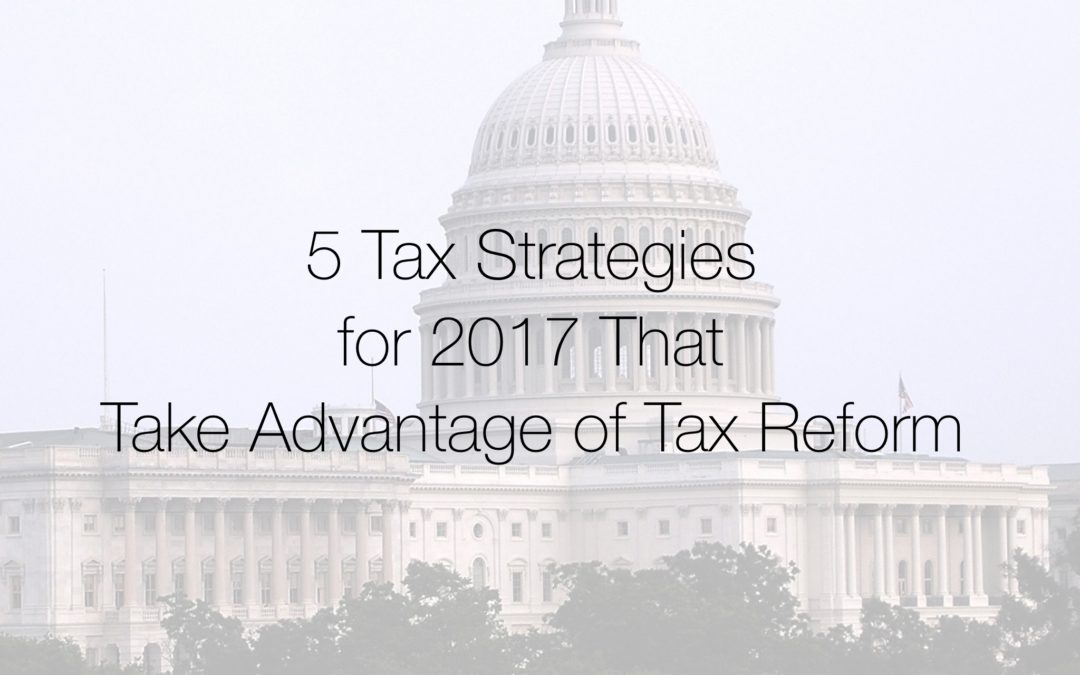The end of the year is traditionally a good time to tackle tax planning, but this year’s tax reform has narrowed the window of opportunity a bit.
Plancorp’s Brian King (Chief Planning Officer) released this note a few days ago to our clients with year end tax tips and a summary of various topics that had been in question prior to the tax bill being finalized.
Plancorp plans to publish additional planning ideas here as we spend more time with the legislation. For now, here are five strategies to consider in the final weeks of 2017.
1. Prepay State/Local Income Tax and Property Tax in 2017
The deductions for state and local income taxes as well as property taxes are limited in 2018 to $10,000, so it is best to accelerate these payments when possible.
For example, when we run tax projections for clients at Plancorp, the client sometimes has a 2017 tax liability that will be due in April 2018. By paying the 2017 state and local tax liability now, the federal deduction for those items are not subject to the $10,000 cap.
With accelerated state and local income taxes, you can only deduct amounts related to 2017 tax liabilities. However, this limitation does not apply to property taxes, so go ahead and pay 2018 property tax if you have the liquidity to do so.
This strategy is not applicable to taxpayers subject to Alternative Minimum Tax (AMT) in 2017 since any state and local taxes are added back under AMT.
2. Accelerate Income Into 2017 to Pay and Deduct Related State Income Tax
If you have any control over the timing of your income, you may consider accelerating income you might otherwise recognize in 2018. For example, if you are planning to exercise options or realize capital gains in 2018 to generate liquidity for your cash flow needs, then go ahead and do that in 2017 instead.
If you’re in a state with an income tax rate greater 6% and you are not in AMT for 2017, the ability to deduct the related state income taxes on accelerated income would outweigh the reduced top bracket in 2018 (39.6% versus 37%).
This strategy applies to single filers with taxable income exceeding $500,000 or married filing jointly taxpayers not in AMT with taxable income exceeding $600,000.
3. Consider Accelerating Other Itemized Deductions
The standard deduction increases from $6,350 to $12,000 for single filers and from $12,700 to $24,000 for married filers. The higher standard deduction means that some of the things you’ve itemized on your tax return in the past might not be itemized in the future.
If you think your 2018 itemized deductions will not exceed the new standard deduction, consider accelerating things such as charitable contributions through the use of a donor advised fund. If you plan to give $10,000 to charity in 2018, make that gift to a donor advised fund in 2017 to realize the deduction this year and then use donor advised fund to grant money to the charities of your choice in 2018 or beyond.
If you have the flexibility, then making multiple years worth of charitable donations to a donor advised fund in 2017 could make a lot of sense.
4. Consider a 529 Plan Contribution
One of the best education planning tools just got better. The new tax bill expands the eligible uses for funds in a 529 plan to be used for K-12 tuition up to $10,000 annually beginning in 2018. Previously, funds in a 529 plan could only be used for post-secondary education expenses.
If your state allows an income tax deduction for 529 contributions and you have not already maxed out that deduction, the consider funding a 529 to take advantage of that state tax deduction. Each state has different deductions related to 529, so be sure to review the rules regarding your state.
Keep in mind that 529 plan contributions are subject to gift tax rules, so you need to be mindful if you have made other gifts to the 529 plan beneficiary in 2017 before making a contribution.
5. Place Qualified Business Property Into Service in 2017
If you are a business owner, you can fully take advantage of the new 100% expensing of qualified business property in 2018 through 2022. However, you may realize an even greater benefit for a deduction in 2017, since the tax rates under current law are generally higher than the new tax rates which will apply beginning in 2018.
Tax rates are set to generally decrease and a 20% deduction will be allowed against Qualified Business Income. However, the 100% expensing of qualified business property provision is one of the few that was made retroactive. It applies to both new and used qualified business property placed into service after September 27, 2017.
Other Implications and Next Steps
While these five strategies offer low downside risk, there are many other implications to consider such as medical deductions, mortgage interest changes, AMT changes, Roth conversions, business implications, estate tax and generation skipping tax exemptions.
Given all of the moving parts, working with a financial advisor to run a detailed tax projection can help minimize error and maximize opportunity. Click here to learn more about working with me.















